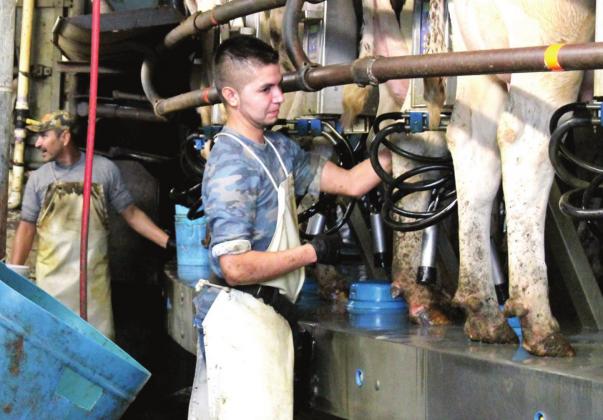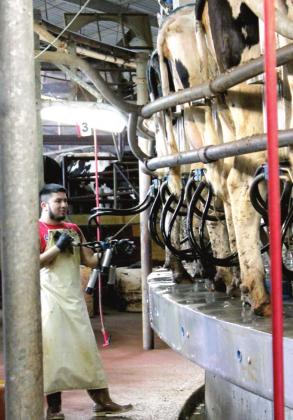According to the CDC, Latinos are the group most vulnerable to COVID-19. They are also a crucial part of Hopkins County’s dairy industry. Here’s why they’re worth the fight.
Disponible en español: haga clic aquí
Hopkins County is nationally famous for its dairy. Texas is currently the No. 5 state in U.S. milk production, according to the Dairy Farmers of America, and Hopkins itself is home to approximately 40 dairy farms, according to Texas A&M AgriLife Extension Agent Mario Villarino.
As COVID-19 descended upon rural Hopkins in the last months, milk producers found that the lifeblood of the dairy industry—Latino immigrant workers—were at the highest risk for the pandemic, according to the Centers for Disease Control and Prevention (CDC). However, the workers themselves weave a complex narrative of their lives here in Hopkins, where they are both susceptible to social determinants of disease and culturally resistant to them.
HUMAN LABOR
“Dairy is an industry that hires a lot of people,” said one of three of the state’s AgriLife dairy specialists with Villarino, Dr. Juan Piñeiro. “A rough estimate is one employee every 100 cows.”
Calculating with census data and Piñeiro’s figures, Hopkins may have approximately 200-300 Latino immigrant workers involved in dairying.
In Hopkins County, most Latino immigrants come from Mexico’s Toluca Valley, Villarino said. Although the elevation is higher, the climate is similar to Hopkins. This region, with its rolling plains, shade trees, long summers and focus on agriculture, also has a long history of dairy.
“Although some come here without experience, some might have already had experience with dairy back home,” Villarino noted. “They come here to join a family member, and then another family member comes. Soon we have whole families living here.”
That’s not to say Spanish-speaking immigrants are a monolith, however, Villarino said. New transplants to Hopkins come from the Atlantic coast of Mexico, from the forested southern Pacific coast, and even from Honduras. Piñeiro’s immigrant population in the panhandle comes from Guatemala and does not speak Spanish as their first language—they speak a Mayan language called Quiché.
In fact, another dimension in Hopkins is added when one considers that some of the largest farms are run by immigrants themselves. During the 1980s, reforms in the dairy industry in Holland caused Dutch immigrants to move to thriving Hopkins in order to escape production caps and tariffs. Under Dutch training, early Mexican immigrants have gained specialized production knowledge and started their own farms, where they now employ more recent migrants, Villarino noted.
“Without immigrants, dairying would not exist in this county,” dairy producer John Merrill of Como told the News-Telegram.
LIVING & WORKING CONDITIONS
Dairy owners, producers and workers often all live together on 1,000- acre properties dotted throughout the county. Housing for workers is often provided on-site at dairy farms, both to save on costs to the producer and ensure that workers are close by for an around-the-clock job, Villarino noted.
“There is no milking twice a day,” Villarino said. “With this many head [of cows] you send them [cows] through constantly. You have to, or you’d never be able to milk them all.”
Trailer homes are provided as housing for workers and their families. Workers see this as both a hindrance and a benefit to stopping infectious disease transmission.
“They hug and kiss and share food, they are amicable just because that’s the culture,” Villarino noted. “We were initially concerned about that with COVID.”
Community transmission routes may be less for the workers, who often live in rural areas and are isolated in family groups, Piñeiro said.
“Most of the dairy workers will work six days a week, so they only go to the grocery store or the city on their day off,” Piñeiro “They are not exposed to a lot of people as frequently.
“At the dairy, most of the workers are outdoors,” Piñeiro added. “The least percentage are indoors, like perhaps some milkers…; however, in this environment you naturally keep distance and sanitation. The risk of contagion on a dairy is much less.”
To date, there has not been a documented outbreak of COVID-19 on a Texas dairy farm, Piñeiro stated.
“We have heard about issues in beef processing plants fighting contagion, but that is related to workers in close proximity,” Piñeiro said.
Villarino described that close personal relationships act as a kind of safety net for social, labor and medical needs.
“In East Texas, they live in the farm, and they are either nuclear families or close friends,” Villarino said. “That facilitates a lot of their relationships. They organize themselves; it’s very sophisticated and very independent. There is a lot of camaraderie and a lot of support.”
“Rudolfo Gamez,” a shift foreman at one of Hopkins County’s largest dairies, agreed. Gamez asked his true name not be identified, as he is undocumented.
“If my boss knows that I have a true emergency, he wouldn’t short me a single cent,” Gamez said. “I know my boss cares a lot for me. At this job, they treat me well.”
EDUCATION
In mid-July, the CDC identified Hispanic or Latinos as the most at-risk group for COVID-19 mortality. Two of top reasons for this distinction included education and healthcare access barriers. Although Hopkins County’s Latinos see these as hurdles, they also see them as tools that can be used to improve their health outcomes.
Gamez described a lack of education among immigrants as a reason for immigration.
“Many people in Mexico are poorly educated and wish they could come here,” he said.
According to Piñeiro, first-generation Latino immigrants on dairies remain unable to gain the education they seek.
“We assessed the level of education, and it was non-finished elementary school,” Piñeiro said.
When it came to the COVID-19 pandemic, this made distributing educational materials difficult.
“In extension materials, we do have to use a lot of images and no scientific language,” Piñeiro said. “We try to put it in very simple terms. We try to make it practical but still science-based.”
According to AgriLife’s Dr. Jennifer Spencer, the close-knit relationships of family- and worker-organized networks can help spread information on COVID-19 education faster and more effectively.
“The point of the educational materials we make is not only on the farm, but also at home for personal wellbeing,” she said. “They have very large families, and it’s about getting the knowledge out there that they could be exposed… if they don’t speak or read fluent English, but we make the materials available to them. They can help educate their families as well.”
ACCESS
“When you go to the doctor, the only thing you need to be afraid of is the bill,” Gamez joked.
In a more serious tone, he added, “For those that don’t have insurance, you have to pay so much more, and that’s really a problem. If you were born here, it’s likely you’ll have insurance, and they [doctors] will respect you more.”
Local religious leader Aide Cadena, whose family contracted and recovered from COVID-19, is still dealing with the financial and physical fallout, she said.
“If you don’t have insurance, they won’t take as much care,” she said. “Many times, a Latino won’t have insurance through their job.”
Cadena said there are other factors that could make it difficult for a Latino immigrant to seek care.
“When a Spanish-speaker doesn’t know enough English, it’s difficult to go to the doctor. It’s difficult to describe what’s happening to you or assert yourself in the language,” she said.
Gamez said that his confidence in seeking medical care for possible COVID-19 symptoms also relies on his language skills.
“Twenty-one years I’ve been here in the U.S.,” he said. “I know my English isn’t the best, but I could assert myself to the doctor and explain everything in English.”
However, dairy farms and farmers were ahead of the curve with implementing safety so Latino cases didn’t end up at the doctor, the experts said.
“Dairy producers have adapted and come up with their own protocols,” Spencer noted. “They want to keep workers safe because without them, the dairy doesn’t function. They are the essential piece to the dairy operation.”
Some of these measures included asking vendors not to approach the lobby building, screening for symptoms and self-isolation. AgriLife also provided a Spanish-only COVID response hotline, Piñeiro said.
In fact, as AgriLife is a trusted source of information and resources for Latino immigrants, the group was heavily involved in disseminating knowledge to the population.
“They [AgriLife] did education, they provided facemasks, there were several many things they were involved in,” Piñeiro said.
Villarino attributes this to AgriLife’s focus on the Latino identity in its approach to education.
“We needed to protect them and acknowledge them in the way they needed help,” Villarino said. “For education to be successful, it had to be adapted to them.”
STILL STRIVING
Hopkins Latinos realize the crucial role they play in the Hopkins County economy. Merrill thinks that more non-farming Americans are understanding now more than ever before how critical food producers are to everyday infrastructure.
“COVID-19 really opened up a vulnerability. I think politicians see that they’re going to have to support agriculture more,” Merrill said. “We need a commitment from the federal government that we’re going to keep agriculture in the United States.”
And at the root of all of it is the immigrants, he said.
“If you want to eat food, you will not be able to eat without immigrant labor,” Merrill stated.
So although Latino immigrants in Hopkins County are aware they are the group most vulnerable to COVID-19, they are positive about what the future holds for them.
“If you follow the law, pay your taxes and act like you’re a member of this country, then this is your country,” Gamez noted. “I’m proud to be here. We all have to take risks sometimes. I worry, but every day, it’s getting better, and if everyone does their part as they should so there’s no more infections, we can avoid the risks.”
Villarino believes dairy will continue to recognize the importance of Latinos, even more so after the COVID pandemic.
“There has to be a willingness of the industry, because Latinos can be a tool and a benefit for our industry,” Villarino said. “They have their own lifestyle and their own identity. We need to give it to them in the way they can adopt it. They are very good at what they do and successful. We need to communicate with them in their terms, where they work and live.”



